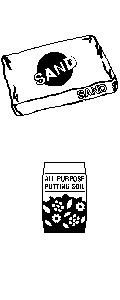 nce you have decided on what you will plant, the next step is planting. But
before you get swept up in enthusiasm and start plopping plants just anywhere
and in any old fassion, there are a few things to be considered.
nce you have decided on what you will plant, the next step is planting. But
before you get swept up in enthusiasm and start plopping plants just anywhere
and in any old fassion, there are a few things to be considered.
When to Plant
Probably the most significant factor determining when to plant is at what point the overnight temperature where you live ceases to drop below freezing. Though some plants can tolerate short stints of a dip of a few degrees below freezing, a good rule of green thumb is to wait until Jack Frost has packed it up for the season and headed for the Southern Hemisphere. Here are some points throughout the US with the months in which their corresponding “last frost times” occur:| Location | Time of Last Frost | Location | Time of Last Frost |
| Atlanta | March | Kansas City | April |
| Boston | May | Huston | February |
| Chicago | April | Los Angeles | February |
| Denver | May | Minneapolis / St. Paul | May |
| Detroit | May | New York City | April |
| San Francisco | February | Seattle | April |
For detailed information about your specific area, consult the UnionTools® Frost Guide.
An option to keep in mind is that of starting plants indoors. You don't have to plant outside imediately upon purchase. Either buy starts or plant from seed inside then transplant to the permanent containers that will be these plants' permanent homes later. A window sill (preferrably a window with southern exposure) makes a good starter green house. If you don't have enough space on the sill for all of your starts, put a table next to the window to accomodate the rest. Two important points about the table you use: (1) make sure it is strong enough (the dirt, sand, and water in plant pots is denser than you might think) and (2) the spill-over from soil drainage is mildly corrosive; if you're concerned about the surface of the table (or the window sill for that matter) being damaged, put a layer of protective sheeting on it (shelf paper or clear plastic works well). There are several reasons why starting indoors might of advantage to you:
- A particular species has a long maturation period and, consequently, you want to make sure the plants get to harvest stage before the first frost in the Fall.
- You live in a climate such as mine (Inland Northwest) that has a short growing season.
- You are ambitious and want to attempt to get two plantings in for the season of certain crops.


Soil
One can easily make a career out of the study of garden soil composition. As a matter fact, many people have made a career out of this and have written on the subject extensively so that we amatures can get on with enjoying our plants if that is our preference. I recommend a quick perusal of a gardening book to get a good grasp on mixing your soil components. One book I would recommend is Ortho's Gardening in Containers. Whatever source you consult, make sure that the information pertains to container gardening. The soil requirements for containers is radically different from that of conventional gardening. Just to get you started, here are some of the terms asscociated with soil components:- Vermiculite
- Spongy mineral granules that retain water when soaked. (Prevents the soil from drying out.)
- Sand
- Makes the soil drain quickly.
- Organics
- Moss, bark and other finely chopped organic materials.

| Home | Plant Selection | Planting Tips | My Plants | Resources |






